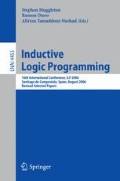Abstract
This paper proposes a mining algorithm for relational frequent patterns based on a bottom-up property extraction from examples. The extracted properties, called property items, are used to construct patterns by a level-wise way like Apriori. The property items are assumed to have a special form, which is defined in terms of mode declaration of predicates. The algorithm produces frequent itemsets as patterns without duplication in the sense of logical equivalence. It is implemented as a system called Mapix and is evaluated with four different datasets with comparison to Warmr. Mapix had large advantage in runtime.
Access this chapter
Tax calculation will be finalised at checkout
Purchases are for personal use only
Preview
Unable to display preview. Download preview PDF.
References
Agrawal, R., Srikant, R.: Fast Algorithms for Mining Association Rules. In: Proc. VLDB, pp. 487–499. Morgan Kaufmann, San Francisco (1994)
Dehaspe, L., De Raedt, L.: Mining association rules with multiple relations. In: Džeroski, S., Lavrač, N. (eds.) Inductive Logic Programming. LNCS, vol. 1297, pp. 125–132. Springer, Heidelberg (1997)
Dehaspe, L.: Frequent pattern discovery in first-order logic, PhD thesis, Department of Computer Science, Katholieke Universiteit Leuven (1998)
Dehaspe, L., Toivonen, H.: Discovery of Relational Association Rules. In: Dzeroski, S., Lavrac, N. (eds.) Relational Data Mining, pp. 189–212. Springer, Heidelberg (2001)
De Raedt, L., Ramon, J.: Condensed Representations for Inductive Logic Programming. In: KR 2004, pp.438–446 (2004)
Flach, P.A., Lachiche, N.: 1BC: A first-order Bayesian classifier. In: Džeroski, S., Flach, P.A. (eds.) Inductive Logic Programming. LNCS (LNAI), vol. 1634, pp. 92–103. Springer, Heidelberg (1999)
Furusawa, M., Inuzuka, N., Seki, H., Itoh, H.: Induction of Logic Programs with More Than One Recursive Clause by Analysing Saturations. In: Džeroski, S., Lavrač, N. (eds.) Inductive Logic Programming. LNCS, vol. 1297, pp. 165–172. Springer, Heidelberg (1997)
Lavrač, N., Flach, P.A.: An extended transformation approach to inductive logic programming. ACM Trans. Computational Logic 2(4), 458–494 (2001)
Marcus, M.P., Santorini, B., Marcinkiewicz, M.A.: Building a large annotated corpus of english: The penn treebank. Comp. Linguistics 19(2), 313–330 (1994)
Michie, D., Muggleton, S., Page, D., Srinivasan, A.: Results of the new east-west challenge (1994), ftp://ftp.comlab.ox.ac.uk/pub/Packages/ILP/Trains/results.tar.Z
Richards, B.L., Mooney, R.J.: Learning Rlations by Pathfinding. AAAI-92, pp. 50–52 (1992)
Rouveirol, C.: Extensions of Inversion of Resolution Applied to Theory Completion. In: Muggleton, S. (ed.) Inductive Logic Programming, pp. 64–90. Academic Press, San Diego (1992)
Srinivasan, A., Muggleton, S., Sternberg, M.J.E., King, R.D.: Theories for Mutagenicity: A Study in First-Order and Feature-Based Induction. Artificial Intelligence 85(1-2), 277–299 (1996)
East-West Challenge: Machine Learning Online Information Service (2000), ftp://ftp.mlnet.org/ml-archive/ILP/public/data/east_west/ at MLnet
Author information
Authors and Affiliations
Editor information
Rights and permissions
Copyright information
© 2007 Springer-Verlag Berlin Heidelberg
About this paper
Cite this paper
Motoyama, JI., Urazawa, S., Nakano, T., Inuzuka, N. (2007). A Mining Algorithm Using Property Items Extracted from Sampled Examples. In: Muggleton, S., Otero, R., Tamaddoni-Nezhad, A. (eds) Inductive Logic Programming. ILP 2006. Lecture Notes in Computer Science(), vol 4455. Springer, Berlin, Heidelberg. https://doi.org/10.1007/978-3-540-73847-3_32
Download citation
DOI: https://doi.org/10.1007/978-3-540-73847-3_32
Publisher Name: Springer, Berlin, Heidelberg
Print ISBN: 978-3-540-73846-6
Online ISBN: 978-3-540-73847-3
eBook Packages: Computer ScienceComputer Science (R0)

